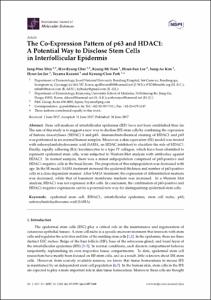The Co-Expression Pattern of p63 and HDAC1: A Potential Way to Disclose Stem Cells in Interfollicular Epidermis
- Keimyung Author(s)
- Kim, Sung Ae
- Department
- Dept. of Dermatology (피부과학)
- Journal Title
- International Journal of Molecular Sciences
- Issued Date
- 2017
- Volume
- 18
- Issue
- 7
- Keyword
- epidermal stem cell; HDAC1; interfollicular epidermis; stem cell niche; p63; suberoylanilohydroxamic acid (SAHA)
- Abstract
- Stem cell markers of interfollicular epidermis (IEF) have not been established thus far. The aim of this study is to suggest a new way to disclose IFE-stem cells by combining the expression of histone deacetylases (HDAC) 1 and p63. Immunohistochemical staining of HDAC1 and p63 was performed in six normal human samples. Moreover, a skin equivalent (SE) model was treated with suberoylanilohydroxamic acid (SAHA, an HDAC inhibitor) to elucidate the role of HDAC1. Finally, rapidly adhering (RA) keratinocytes to a type IV collagen, which have been identified to represent epidermal stem cells, were subjected to Western blot analysis with antibodies against HDAC1. In normal samples, there was a minor subpopulation comprised of p63-positive and HDAC1-negative cells in the basal layers. The proportion of this subpopulation was decreased with age. In the SE model, SAHA treatment increased the epidermal thickness and number of p63-positive cells in a dose dependent manner. After SAHA treatment, the expression of differentiation markers was decreased, while that of basement membrane markers was increased. In a Western blot analysis, HDAC1 was not expressed in RA cells. In conclusion, the combination of p63-positive and HDAC1-negative expressions can be a potential new way for distinguishing epidermal stem cells.
- Keimyung Author(s)(Kor)
- 김성애
- Publisher
- School of Medicine
- Citation
- Jung-Won Shin et al. (2017). The Co-Expression Pattern of p63 and HDAC1: A Potential Way to Disclose Stem Cells in Interfollicular Epidermis. International Journal of Molecular Sciences, 18(7), 1360–1360. doi: 10.3390/ijms18071360
- Type
- Article
- ISSN
- 1422-0067
- Appears in Collections:
- 1. School of Medicine (의과대학) > Dept. of Dermatology (피부과학)
- 파일 목록
-
-
Download
 oak-2017-0163.pdf
기타 데이터 / 8.25 MB / Adobe PDF
oak-2017-0163.pdf
기타 데이터 / 8.25 MB / Adobe PDF
-
Items in Repository are protected by copyright, with all rights reserved, unless otherwise indicated.